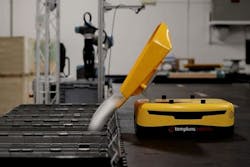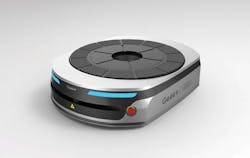The Business Case for Robotics in Distribution Centers
Automated Distribution Centers Have the Edge
The outbreak of COVID-19 revealed shortcomings in the logistics environment, such as labor shortages, weak infrastructure, and a lack of flexibility to quickly adapt to rapidly changing market conditions. The distribution centers (DCs) that already had automation solutions in place enjoyed significant advantages during the immediate aftermath of the COVID-19 outbreak.
With automation in place, these DCs were able to respond to the sudden market changes and increased demand with greater flexibility. Automation also allowed these DCs to optimize human labor, which became scarcer as social distancing measures were put in place, by shifting workers to where they were most needed and maintaining higher productivity.
DCs that are using automation solutions are continuing to thrive, despite challenging conditions—proving the value of next-generation logistics automation solutions. Not only do innovative and automated technologies enable unprecedented capability and performance, but also make these systems significantly more integrated and cost-efficient than ever.
Manual DCs Are No Longer Competitive
The majority of today’s DCs still lack automation for most jobs. Despite the mental and physical advantages, human labor isn’t always the best choice for common DC tasks, which can be repetitive, tedious, and even injury-prone. Productivity and safety suffer when humans get bored, fatigued, or distracted.
There’s also a disconnect between the supply and demand for manufacturing capabilities—while the number of available manufacturing jobs is growing, the pool of qualified candidates isn’t. Even before the pandemic increased the demand for manufacturing workers, roughly 10,000 baby boomers were reaching retirement age every day—with fewer younger workers available to replace them.
Unfortunately for DC operators, these trends are set to continue for more than a decade. While virus-related unemployment in other sectors may temporarily increase the available labor pool in the short term, the problem is only going to get worse. DCs that want to remain competitive will need to act quickly as employment levels normalize.
Not only are human laborers in short supply, but they are also getting more expensive due to a shortage of warehouse workers and turnover rates as high as 36%. Replacing workers can cost 25 to 150% of an employee’s salary, depending on the employee’s role and the company’s recruitment process. Qualitative costs include a lack of continuity, lost productivity, and employees covering for open positions.
DCs also risk costly fines, chargebacks, and lost contracts if they don’t have enough labor to meet service level agreements (SLAs).
Not only can these costs be high on their own, but they’re adding stress for DC operators who are grappling with unprecedented demand for seamless e-commerce operations and fast, free shipping.
Robots To the Rescue
In the past, DCs may have been resistant to implementing automation due to high costs or complexity. However, automation costs are decreasing. Since 2014, the price of industrial robots has dropped more than 25%. By 2025, the price is expected to decrease by an additional 22%.
DC automation is becoming increasingly easier to implement and utilize, thanks to significant advances in simulation, sensors, vision, mobility, computing power, machine learning, artificial intelligence (AI), and connectivity. Let’s explore a few examples.
Automation Transformation Examples
There are several ways that autonomous mobile robots (AMRs) can transform DC operations.
Heavy Load or Pallet Transport
Heavy loads are typically moved with forklifts. Given the scarcity of human labor, this is an inefficient use of workers’ time and efforts, which can be better applied toward more advanced needs.
Fleet management software and pallet conveyance AMRs offer a better solution for heavy load movement. Once a pallet is ready to be moved, fleet management software is able to handle the entire moving process, from assigning the appropriate AMR to pick up the pallet load to orchestrating the routing of the pallet to the appropriate destination.
Once it receives instruction from the fleet management software, the selected robot picks up the pallet load and transports it by autonomously navigating through the facility, avoiding obstacles along the way, until it arrives at the designated location. The robot drops off the pallet load at the destination location station, which is reported to the manufacturing execution system (MES), warehouse execution software (WES) or an operator. The robot then receives its next assignment or instructions to return to a “home” position.
Processing Returns
With an increase in e-commerce sales comes an increase in returns. While in-store purchases are typically returned at a rate of 8%, online purchases are returned at a rate of 25%. Warehouses need to make sure their processes are able to handle frequent and large amounts of returns.
Returned or refurbished items are sent to a facility where they must be sorted and transported to various locations. Conveyors and other traditional fixed automation solutions don’t work well for these tasks, which often involve extensive travel, complex routing, and the inherent variability of reverse logistics. Returns, refurbishment, and recycling processes add additional challenges because they require secondary and tertiary routing among multiple workstations.
Robotic solutions can help streamline the returns and refurbished process from start to finish. Robotic solutions receive and manually sort returned or refurbished items into bins on AMR carts. These carts are then placed into a pick-up location for workstations, where the operator scans a placard to signal the AMR fleet. The robot picks up and delivers the cart to the appropriate workstation, where the bins are manually removed for processing. Once the cart is emptied, the operator positions it in a pick-up location and scans a return placard, informing the fleet management system that the cart is ready for re-use.
There are more advanced robotic solutions equipped with touch-screen capabilities. Using these devices, operators can use a touch-screen interface to select from a list of destinations for the cart as required by the returns process workflow.
Assisted Picking
Order pickers can spend at least half of their time manually transporting items between picking racks and pack-out stations. It’s not unusual for workers to walk more than five miles a day.
Deploying AMRs in the same aisles as picking operators can dramatically streamline productivity. Based on fulfillment order needs, AMRs are directed to the locations of the item(s) to be picked. The AMR’s display indicates the item to pick and its location. Once the operator picks and scans the item, the AMR automatically drives to the next pick location while the operator moves on to the next robot.
Once the AMR has picked all of its assigned items, it is routed to a pack-out or a value-added service (VAS) cell for packing and shipping. After the AMR is unloaded, the pack-out operator indicates that the unit is ready to be redeployed. The fleet management software then generates a new picking order and sends the unit back to the picking aisles.
Robots Mean Business
The events of 2020 have accelerated many e-commerce trends. These changes are here to stay and are highlighting the entire industry’s need to implement an expanded use of robotics. The examples of automation in DCs detailed here illustrate just a few of the ways today’s advanced automation solutions enable warehouses to take advantage of the latest innovations with minimal cost and technical risk.
Automation is critical to remaining competitive in response to unprecedented market changes and the operations that are willing to embrace automation will be much more likely to thrive.
Thomas Evans is the CTO of Honeywell Robotics.
About the Author

Thomas H. Evans
Robotics CTO, Honeywell Safety and Productivity Solutions
Thomas H. Evans serves as the Robotics Chief Technology Officer for Honeywell. In this role, he is responsible for providing the technical vision and development for robotics and ASRS shuttle solutions. He works closely with the Honeywell Offering Management teams to target and develop robotic solutions to assist its customers in addressing the issues and technology advancement initiatives while driving Honeywell’s Path to Dark Warehouse development and Micro Distribution Center advancements.
In previous roles, he served as the Chief Technology Officer for Orbital Engineering, worked as a Research Associate Professor at West Virginia University, and consulted for various robotics projects for the NASA Goddard Space Flight Center. He obtained a Ph.D. and MS in Mechanical Engineering from West Virginia University and a BS in Mechanical Engineering from Wichita State University.



